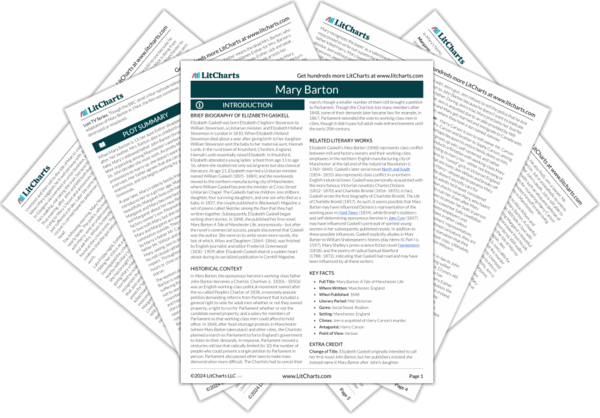In Mary Barton, the caricature that mill owner’s son Harry Carson draws of starving workers’ representatives symbolizes employers’ lack of empathy toward their working-class employees—and vice versa. The caricature first appears in the novel during a strike, when the mill and factory owners meet with the representatives of the starving workers to try to come to an agreement about acceptable wages. Harry, the wealthy son of a mill owner, sketches the caricature of the ragged, starving workers’ representatives, writes a quotation from William Shakespeare’s Henry IV, Part I (c. 1597) on it, and passes it around to the other mill and factory owners to amuse them. This incident shows the employers’ lack of empathy for their starving employees: they see the working men not as fellow human beings but as objects of laughter or as pitiable minor characters in a Shakespeare play.
When the workers find the discarded caricature—Harry throws it at the fire and misses—they are desperate and outraged. They are unable to see Harry as he really is: one young, thoughtless, and occasionally cruel human being. Instead, they see him as a distillation of every employer who has exploited them and all the suffering they have undergone as a result. The outraged workers decide to murder Harry to terrify the employer class. They tear up the caricature, mark one strip, and then draw strips to determine who will carry out the murderer. Thus, while the caricature initially represents the employers’ lack of empathy toward their employees, it comes to represent the workers’ violent dehumanization of the employer class in response to that original lack of empathy.
Caricature Quotes in Mary Barton
While the men had stood grouped near the door, on their first entrance, Mr Harry Carson had taken out his silver pencil, and had drawn an admirable caricature of them—lank, ragged, dispirited and famine-stricken. Underneath he wrote a hasty quotation from the fat knight’s well-known speech in Henry IV. He passed it to one of his neighbours, who acknowledged the likeness instantly, and by him it was sent round to others, who all smiled and nodded their heads.
A number of pieces of paper (from the identical letter on which the caricature had been drawn that very morning) were torn up, and one was marked.












